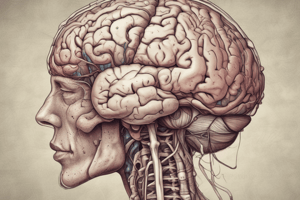Podcast
Questions and Answers
What is the largest part of the brain responsible for higher brain functions?
What is the largest part of the brain responsible for higher brain functions?
- Cerebrum (correct)
- Medulla Oblongata
- Pons
- Cerebellum
What are gyri?
What are gyri?
Ridges on the surface of the brain.
What are sulci?
What are sulci?
Grooves on the surface of the brain.
What connects the left and right cerebral hemispheres?
What connects the left and right cerebral hemispheres?
What is the function of the pituitary gland?
What is the function of the pituitary gland?
What is the role of the brain stem?
What is the role of the brain stem?
What are the primary functions of the midbrain?
What are the primary functions of the midbrain?
What is the pons responsible for?
What is the pons responsible for?
What part of the brain controls autonomic functions like heart rate?
What part of the brain controls autonomic functions like heart rate?
What is the spinal cord's function?
What is the spinal cord's function?
What is the function of the 4th ventricle in the brain?
What is the function of the 4th ventricle in the brain?
What is the cerebellum primarily responsible for?
What is the cerebellum primarily responsible for?
What does the arbor vitae refer to?
What does the arbor vitae refer to?
What is the pineal gland associated with?
What is the pineal gland associated with?
What is the role of the cerebral aqueduct?
What is the role of the cerebral aqueduct?
What does the lateral ventricle contain?
What does the lateral ventricle contain?
What part of the brain is involved in sensory and motor signal relay?
What part of the brain is involved in sensory and motor signal relay?
What regulates body temperature, hunger, and thirst?
What regulates body temperature, hunger, and thirst?
What is the diencephalon?
What is the diencephalon?
Flashcards are hidden until you start studying
Study Notes
Brain Anatomy Terms
-
Cerebrum: The largest part of the brain, responsible for higher brain functions, including thought and action. Divided into left and right hemispheres.
-
Gyri: Raised folds or ridges on the surface of the brain, increasing the brain's surface area and enhancing its cognitive abilities.
-
Sulci: Grooves between the gyri on the brain's surface, helping to delineate different areas of the brain.
-
Corpus Callosum: A thick band of nerve fibers that connects the left and right cerebral hemispheres, facilitating interhemispheric communication.
-
Pituitary Gland: Known as the 'master gland,' it regulates various hormonal functions in the body and is part of the endocrine system.
-
Brain Stem: Connects the brain to the spinal cord and controls basic life functions such as breathing, heart rate, and blood pressure.
-
Midbrain: Located in the brainstem, it plays a crucial role in vision, hearing, and motor control.
-
Pons: A section of the brainstem that acts as a bridge between different parts of the nervous system, important for regulating sleep and arousal.
-
Medulla Oblongata: The lower part of the brainstem; responsible for autonomic functions like heartbeat and respiration.
-
Spinal Cord: A long, thin bundle of nervous tissue extending from the brainstem down the vertebral column, responsible for transmitting signals between the brain and the rest of the body.
-
4th Ventricle: A fluid-filled cavity in the brain located between the brainstem and the cerebellum; involved in the production and circulation of cerebrospinal fluid.
-
Cerebellum: Positioned at the back of the brain, it plays a crucial role in motor control, coordination, and balance.
-
Arbor Vitae: The tree-like appearance of white matter in the cerebellum, essential for transmitting information from the cerebellum to the rest of the brain.
-
Pineal Gland: A small endocrine gland located near the center of the brain, responsible for producing melatonin, which regulates sleep-wake cycles.
-
Cerebral Aqueduct: A narrow channel connecting the 3rd and 4th ventricles in the brain, allowing the flow of cerebrospinal fluid.
-
Lateral Ventricle: A pair of large cavities in the brain that contain cerebrospinal fluid, contributing to nutrient transport and waste removal.
-
Thalamus: Acts as a relay station for sensory information, directing it to appropriate areas of the brain for processing.
-
Hypothalamus: A small but crucial area that regulates essential functions such as temperature control, thirst, hunger, and circadian rhythms.
-
Diencephalon: A region of the brain that includes the thalamus and hypothalamus, functioning as a hub for sensory and autonomic pathway processing.
Studying That Suits You
Use AI to generate personalized quizzes and flashcards to suit your learning preferences.




